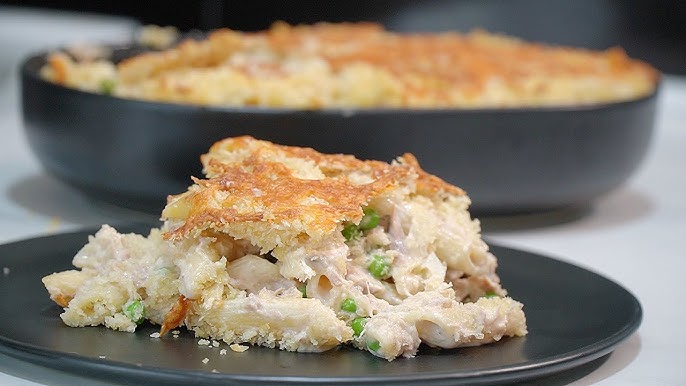Classic Tuna Casserole Recipe: Tuna casserole has stood the test of time because it’s the perfect combination of comfort food, affordability, and convenience. Many families have grown up with this dish on the dinner table because it brings warmth, nostalgia, and simplicity to mealtime. The flavors are familiar—tender pasta, creamy sauce, and hearty tuna all baked together with a crispy topping. It’s not just delicious, it’s also budget-friendly and can easily feed a crowd. That’s why it has remained a go-to meal for busy parents, students, and anyone craving a hearty homemade dinner without spending hours in the kitchen.
History and Origin of Tuna Casserole
The tuna casserole became popular in the United States around the 1950s. At the time, convenience foods like canned tuna, canned soup, and pasta were household staples. This dish was invented as a way to create a wholesome meal with inexpensive pantry ingredients. Over the years, variations emerged—some families preferred extra cheese, while others loved adding vegetables for a healthier twist. Today, tuna casserole is still celebrated as a comforting, retro dish that has adapted to modern kitchens while staying true to its roots.
Ingredients You’ll Need
Main Ingredients for Tuna Casserole
To make the classic version of tuna casserole, you’ll need a handful of simple ingredients, most of which you probably already have in your kitchen. These include:
- Pasta (egg noodles or rotini work best)
- Canned tuna (packed in water or oil, drained well)
- Cream of mushroom soup (for the creamy base)
- Milk (to thin the sauce slightly)
- Frozen peas (adds sweetness and color)
- Shredded cheese (cheddar is most common)
- Breadcrumbs or crushed potato chips (for the topping)
- Butter (to help crisp the topping)
- Salt, pepper, and garlic powder (for seasoning)
These are the essentials, but the beauty of tuna casserole is that it can be customized easily.
Optional Add-Ins for Extra Flavor
Want to level up your casserole? Here are some tasty extras you can toss in:
- Sautéed mushrooms for earthy flavor
- Chopped onions for sweetness
- Diced carrots for crunch
- Broccoli or spinach for a veggie boost
- A dash of hot sauce for a subtle kick
- Parmesan cheese for a nutty finish
Substitutes for Healthier Versions
If you want a lighter or healthier version, try these substitutions:
- Use whole wheat pasta instead of white pasta
- Swap Greek yogurt or low-fat sour cream for cream of mushroom soup
- Choose low-fat cheese instead of full-fat versions
- Add extra vegetables to bulk up the dish without extra calories
- Replace breadcrumbs with crushed whole grain crackers
Kitchen Tools Required
Essential Cooking Equipment
Before you get started, make sure you have the right tools on hand:
- Large pot (for boiling pasta)
- Strainer (to drain pasta)
- Large mixing bowl (for combining ingredients)
- Baking dish (9×13-inch works perfectly)
- Wooden spoon or spatula (for stirring)
Helpful Extras to Make Cooking Easier
While not absolutely necessary, these extras can make cooking smoother:
- Non-stick spray (to prevent sticking in the baking dish)
- Measuring cups and spoons (for accuracy)
- Cheese grater (if using block cheese)
- Oven mitts (safety first!)
Step-by-Step Guide to Making Tuna Casserole
Preparing the Ingredients
Start by draining your canned tuna thoroughly—excess liquid can make the casserole soggy. If you’re adding fresh vegetables like onions or mushrooms, sauté them in a little butter or olive oil until soft. This step brings out their flavors and prevents them from releasing too much moisture during baking. Preheat your oven to 375°F (190°C) while you prepare the rest of the dish.
Cooking the Pasta Perfectly
Cook your pasta just until al dente. Remember, it will continue cooking in the oven, so don’t overdo it. Once cooked, drain the pasta and set it aside. Toss it lightly with a drizzle of olive oil to keep it from sticking together.
Mixing the Tuna and Sauce
In a large mixing bowl, combine the cream of mushroom soup, milk, seasonings, and cheese. Stir until smooth and creamy. Fold in the tuna and peas, making sure everything is evenly coated. Finally, add the pasta and gently mix to ensure the sauce reaches every bite.
Assembling the Casserole
Grease your baking dish lightly, then pour in the pasta mixture. Spread it out evenly so it cooks consistently. Top with a generous layer of shredded cheese and your choice of breadcrumbs or crushed potato chips mixed with melted butter. This topping gives the casserole that irresistible golden crunch.
Baking to Perfection
Bake uncovered in your preheated oven for 25–30 minutes, or until the top is golden brown and bubbly. Once done, let it rest for about 5 minutes before serving. This helps the casserole set and makes it easier to cut and serve neatly.
Tips for the Best Tuna Casserole
Preventing a Dry Casserole
One of the biggest mistakes people make is ending up with a dry tuna casserole. To avoid this, make sure you add enough liquid to the sauce. If it looks too thick before baking, stir in a splash of milk. Also, don’t overbake—it just needs to heat through and get bubbly.
Enhancing the Flavor
Want a richer flavor? Swap cream of mushroom soup with cream of chicken or celery. Add extra seasonings like paprika, thyme, or parsley for depth. A splash of Worcestershire sauce can also boost the savory flavor.
Serving Suggestions
Tuna casserole is a complete meal on its own, but you can serve it with a light side dish to balance the richness. Try:
- A crisp green salad with vinaigrette
- Steamed broccoli or green beans
- Garlic bread or dinner rolls
Variations of Tuna Casserole
Cheesy Tuna Casserole
If you’re a cheese lover, then this variation will quickly become your favorite. Instead of using just a small amount of shredded cheese in the mixture, double it up by adding cheddar, mozzarella, or even Monterey Jack cheese for that gooey, melty bite. For an even richer flavor, mix in cream cheese or a dollop of sour cream. The cheese not only enhances the taste but also creates a creamier consistency that pairs perfectly with the tuna. You can also top the casserole with a blend of cheeses before baking to create a bubbly, golden crust that everyone will want seconds of. This variation is perfect for kids and adults alike, especially if you want your casserole to feel indulgent and extra comforting.
Healthy Tuna Casserole
For those who want to enjoy this dish without the guilt, a lighter version is just as satisfying. Instead of using cream of mushroom soup, try making your own light sauce using low-fat milk thickened with a little flour or cornstarch. Swap the regular pasta with whole wheat or chickpea pasta for extra fiber and protein. Add in plenty of vegetables such as zucchini, broccoli, spinach, or even bell peppers to bulk up the dish while keeping it low in calories. Instead of potato chips or breadcrumbs, you can top it with crushed almonds, sunflower seeds, or panko for a crunchy yet healthier finish. This version makes you feel full and nourished while still enjoying the classic comfort of tuna casserole.
Kid-Friendly Tuna Casserole
Sometimes, picky eaters make it tricky to prepare family meals. Luckily, tuna casserole can be made kid-friendly with just a few tweaks. Stick to creamy cheese sauces instead of mushroom soup if your child doesn’t like the earthy flavor. Use fun-shaped pasta like spirals, bow ties, or shells to make the dish more appealing. Mixing in small amounts of veggies like peas or carrots can help introduce kids to vegetables without overwhelming them. For an extra touch, top the casserole with crushed cheese crackers instead of breadcrumbs—kids will love the familiar cheesy crunch. This fun, comforting version is guaranteed to be a hit at the dinner table.
Storing and Reheating Tuna Casserole
Refrigeration Tips
If you’re making tuna casserole ahead of time or have leftovers, proper storage is key to maintaining flavor and texture. Once the casserole has cooled completely, cover it tightly with plastic wrap or aluminum foil. You can also transfer it to an airtight container. Refrigerated tuna casserole will last for 3–4 days. When storing, keep the topping separate if possible, so it stays crunchy when reheated.
Freezing Tuna Casserole
Tuna casserole is one of the best meals to freeze for later. To freeze, assemble the casserole but don’t bake it yet. Cover tightly with plastic wrap, then wrap again in foil for extra protection against freezer burn. It can be frozen for up to 3 months. When ready to enjoy, thaw it overnight in the fridge, then bake as directed. If you want to freeze leftovers, portion them into freezer-safe containers for easy reheating later.
Best Way to Reheat
Reheating tuna casserole is simple, but you need to do it right to avoid drying it out. The oven is the best option—preheat to 350°F (175°C), cover the casserole with foil, and bake for about 20 minutes until heated through. If reheating a single portion, you can use the microwave, but add a splash of milk and cover with a microwave-safe lid to keep it moist. For the crispiest topping, pop it under the broiler for a few minutes after reheating.
Nutritional Value of Tuna Casserole
Calories and Macronutrients
The nutritional content of tuna casserole depends on the recipe and ingredients used, but on average, one serving (about 1 cup) contains:
- Calories: 300–400
- Protein: 20–25g
- Carbohydrates: 30–35g
- Fat: 12–18g
- Fiber: 2–4g
This makes tuna casserole a relatively balanced meal, providing a good mix of protein from the tuna, carbs from the pasta, and fat from the cheese and sauce.
Health Benefits of Key Ingredients
- Tuna: A rich source of lean protein and omega-3 fatty acids, which support heart and brain health.
- Pasta: Provides energy through complex carbohydrates, especially if you use whole wheat pasta.
- Vegetables (peas, carrots, spinach): Add fiber, vitamins, and minerals to balance the dish.
- Cheese and Milk: Supply calcium and vitamin D for strong bones.
By making a few healthy substitutions, you can turn tuna casserole into a nutrient-packed comfort meal.
FAQs about Classic Tuna Casserole Recipe
1. Can I make tuna casserole without soup?
Yes! You can create a homemade sauce using milk, butter, and flour as a base instead of canned soup.
2. What can I use instead of tuna?
You can substitute canned chicken, salmon, or even turkey for a different twist.
3. How do I keep the casserole from being too fishy?
Use tuna packed in water, drain it well, and mix it with extra seasonings or lemon juice to balance the flavor.
4. Can I add rice instead of pasta?
Absolutely—rice works well and makes the dish even more hearty.
5. What’s the best topping for tuna casserole?
Classic breadcrumbs or potato chips are great, but crushed crackers, pretzels, or even fried onions can add a fun twist.
Conclusion
Tuna casserole is more than just a meal—it’s a classic comfort dish that has been enjoyed by families for generations. With its creamy sauce, tender pasta, and crunchy topping, it’s the perfect combination of flavor and texture. The best part is its versatility—you can stick to the classic recipe, make it extra cheesy, lighten it up with healthier substitutions, or even make it more kid-friendly. Plus, it stores and reheats beautifully, making it a fantastic meal-prep option. Whether you’re cooking for your family, friends, or just yourself, this tuna casserole recipe is guaranteed to bring warmth and satisfaction to the table.



